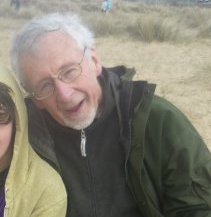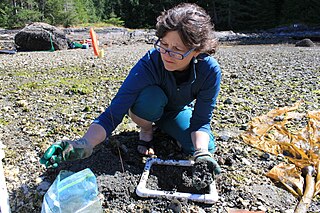
Millets are a group of highly variable small-seeded grasses, widely grown around the world as cereal crops or grains for fodder and human food.

Quinoa is a flowering plant in the amaranth family. It is a herbaceous annual plant grown as a crop primarily for its edible seeds; the seeds are rich in protein, dietary fiber, B vitamins, and dietary minerals in amounts greater than in many grains. Quinoa is not a grass, but rather a pseudocereal botanically related to spinach and amaranth, and originated in the Andean region of northwestern South America. It was first used to feed livestock 5.2–7.0 thousand years ago, and for human consumption 3–4 thousand years ago in the Lake Titicaca basin of Peru and Bolivia.

Pal(a)eoethnobotany or archaeobotany is a sub-field of environmental archaeology that studies plant remains from archaeological sites. Basing on the recovery and identification of plant remains and the ecological and cultural information available for modern plants, the major research themes are the use of wild plants, the origins of agriculture and domestication, and the co-evolution of human-plant interactions. Archaeobotany is arguably now a mature discipline, but one that is facing challenges relating to data and communication.

The Eastern Agricultural Complex was one of about 10 independent centers of plant domestication in the pre-historic world. By about 1800 BCE the Native Americans of North America were cultivating several species of plants, thus transitioning from a hunter-gatherer economy to agriculture. After 200 BCE when maize from Mexico was introduced to the Eastern Woodlands, the Native Americans of the present-day United States and Canada slowly changed from growing local indigenous plants to a maize-based agricultural economy. The cultivation of local indigenous plants other than squash declined and was eventually abandoned. The formerly domesticated plants, except for squash, returned to their wild forms.

Ancient Maya cuisine was varied and extensive. Many different types of resources were consumed, including maritime, flora, and faunal material, and food was obtained or produced through strategies such as hunting, foraging, and large-scale agricultural production. Plant domestication concentrated upon several core foods, the most important of which was maize.

Chenopodium berlandieri, also known by the common names pitseed goosefoot, huauzontle, lamb's quarters, and lambsquarters is an annual herbaceous plant in the family Amaranthaceae.
Gayle J. Fritz is an American paleoethnobotanist working out of Washington University in St. Louis. She is a world expert on ancient crops. Fritz runs the Paleoethnobotany Lab at Washington University in St. Louis under the auspices of the Anthropology Department.

Gordon Hillman was a British archaeobotanist and academic at the UCL Institute of Archaeology. He has been described as "a pivotal figure in the development of archaeobotany at the Institute of Archaeology at University College London, [who] through his research, publications and teaching had a major influence on the field worldwide."
David G. Anderson is an archaeologist in the department of anthropology at the University of Tennessee, Knoxville, who specializes in Southeastern archaeology. His professional interests include climate change and human response, exploring the development of cultural complexity in Eastern North America, maintaining and improving the nation's Cultural Resource management (CRM) program, teaching and writing about archaeology, and developing technical and popular syntheses of archaeological research. He is the project director of the on-line Paleoindian Database of the Americas (PIDBA). and a Co-Director, with Joshua J. Wells, Eric C, Kansa, and Sarah Whitcher Kansa, of the Digital Index of North American Archaeology (DINAA)
Deborah M. Pearsall is an American archaeologist who specializes in paleoethnobotany. She maintains an online phytolith database. She is a full professor in the Department of Anthropology at the University of Missouri in Columbia, Missouri, where she first began working in 1978. She received her Ph.D. in anthropology from the University of Illinois at Urbana-Champaign in 1979, with a dissertation entitled The Application of Ethnobotanical Techniques to the Problem of Subsistence in the Ecuadorian Formative.
George R. Milner, Ph.D., is an archaeologist in the Department of Anthropology at The Pennsylvania State University. He has done extensive archaeological research on sites encompassing a wide range of time periods in Illinois, Missouri, Wisconsin, and Kentucky, and has also worked in Egypt and Saipan (Micronesia). He has worked with prehistoric and historic human skeletal remains from eastern North America, Denmark, and Egypt. By using modern samples of known age from the United States, Switzerland, and Portugal, he has helped refine skeletal age estimation techniques.

Robert Laurens Kelly is an American anthropologist who is a Professor at the University of Wyoming. As a professor, he has taught introductory Archaeology as well as upper-level courses focused in Hunter-Gathers, North American Archaeology, Lithic Analysis, and Human Behavioral Ecology. Kelly’s interest in archaeology began when he was a sophomore in high school in 1973. His first experience in fieldwork was an excavation of Gatecliff Rockshelter, a prehistoric site in central Nevada. Since then, Kelly has been involved with archaeology and has dedicated the majority of his work to the ethnology, ethnography, and archaeology of foraging peoples, which include research on lithic technology, initial colonization of the New World, evolutionary ecology of hunter-gatherers, and archaeological method and theory. He has been involved in research projects throughout the United States and in Chile, where he studied the remains of the Inca as well as coastal shell middens, and Madagascar, where in order to learn about farmer-forager society, Kelly has participated in ethnoarchaeological research. A majority of his work has been carried out in the Great Basin, but after moving to Wyoming in 1997 he has shifted his research to the rockshelters in the southwest Wyoming and the Bighorn Mountains.

Iraq ed-Dubb, or the Cave of the Bear, is an early Neolithic archeological site 7 km (4.3 mi) northwest of Ajlun in the Jordan Valley, in modern-day Jordan. The settlement existed before 8,000 BCE and experimented with the cultivation of founder crops, side by side with the harvesting of wild cereals. Along with Tell Aswad in Syria, the site shows the earliest reference to domestic hulled barley between 10,000 and 8,800 BCE. The site is located on a forested limestone escarpment above the Wadi el-Yabis in northwest Jordan. An oval-shaped stone structure was excavated along with two burials and a variety of animal and plant remains.
Jefferson Chapman is an archaeologist who conducted extensive excavations at sites in eastern Tennessee, recovering evidence that provided the first secure radiocarbon chronology for Early and Middle Archaic period assemblages in Eastern North America. He also is a research professor in anthropology and the Director of the Frank H. McClung Museum at the University of Tennessee, Knoxville. Chapman’s professional interests include Southeastern archaeology, paleoethnobotany, museology and public archaeology.

Bruce D. Smith is an American archaeologist and curator at the Smithsonian Institution's National Museum of Natural History who primarily focuses on the interaction of humans with their environment, especially the origins of agriculture in eastern North America agricultural complex.
James F. O'Connell is Distinguished Professor Emeritus of Anthropology at the University of Utah. He is a member of the National Academy of Sciences of the United States of America and is on the editorial board of the Proceedings of the National Academy of Sciences.
Judith Sealy is a Professor and South Africa Research Chairs Initiative Research Chair in Archaeology and Paleoenvironmental Studies and director of the Stable Light Isotope Lab in the Department of Archaeology at University of Cape Town.
Christine Hastorf is an archaeologist and is currently Professor in the Anthropology department at the University of California, Berkeley. Her research focuses on agriculture, political complexity, gender, archaeobotany, and the archaeology of the Andes.

Dana Sue Lepofsky is a Canadian archaeologist and ethnobiologist. She is a professor at Simon Fraser University, a former president of the Society of Ethnobiology, and received the Smith-Wintemberg Award in 2018. Her research focuses on the historical ecology of the indigenous peoples of the Pacific Northwest Coast.










